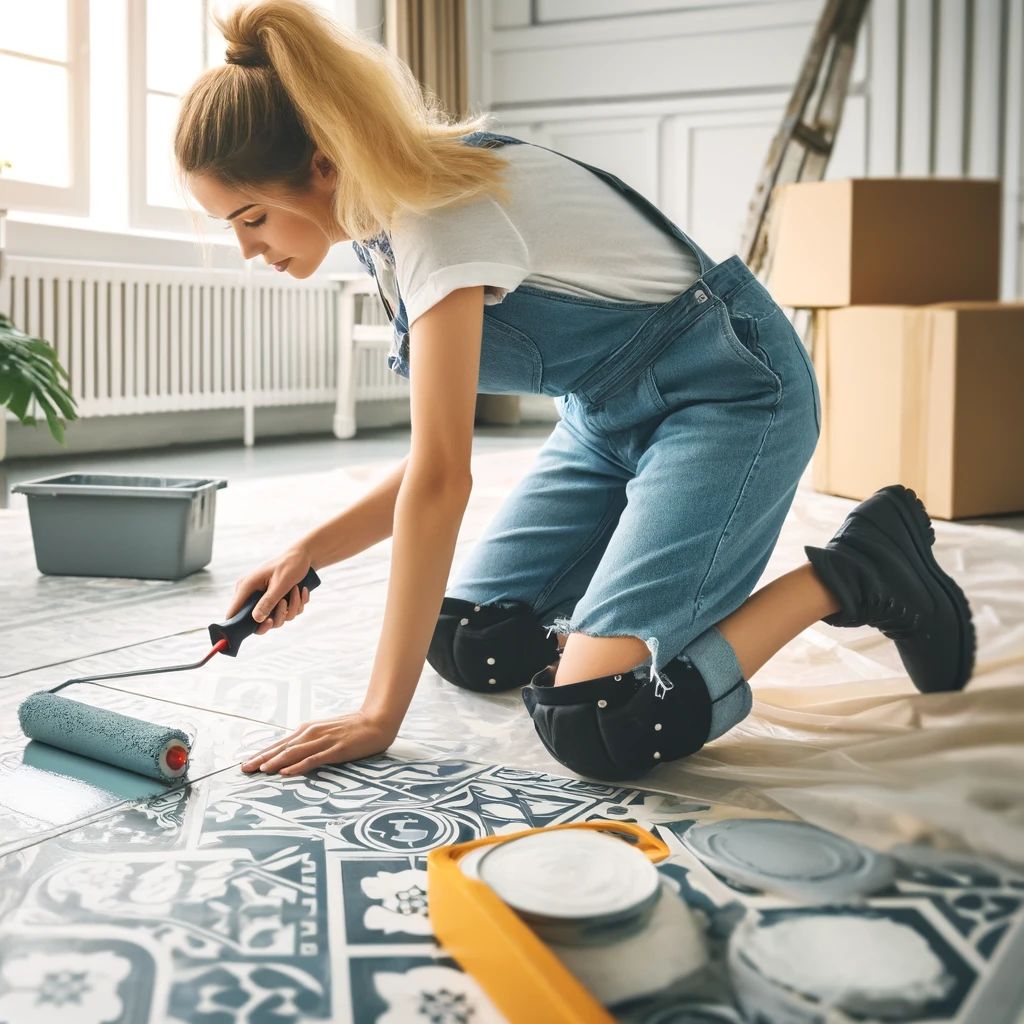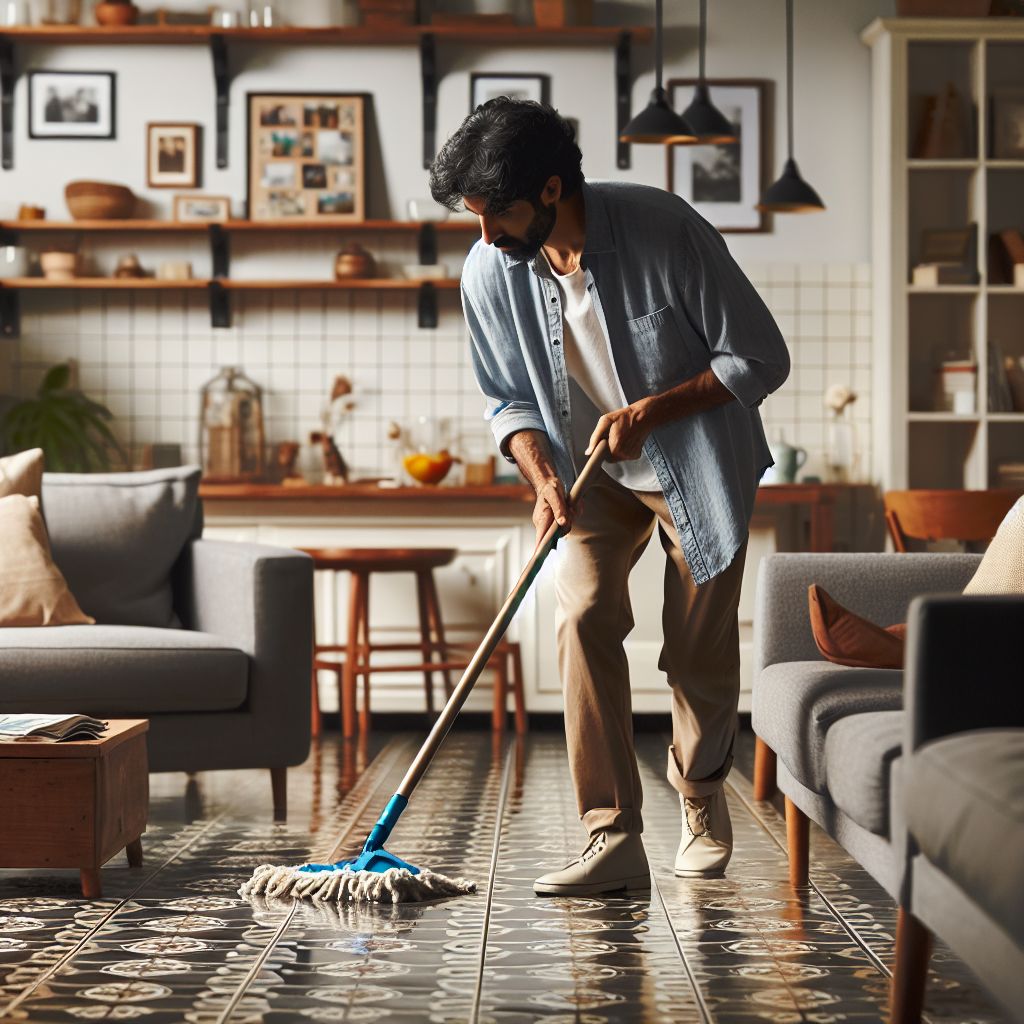
Key Takeaways
- Refinishing ceramic tile flooring is a cost-effective alternative to replacement.
- Essential tools include cleaner, sandpaper, primer, paint, and sealant.
- Preparation is key– clean, repair, and sand your tiles for the best results.
- Use high-quality primer and paint designed for ceramic tile for longevity.
- Regular maintenance can extend the life of your refinished floor.
Revitalizing Your Home with DIY Ceramic Tile Refinishing
Is your ceramic tile floor showing its age? Maybe it’s lost its luster, or the color just doesn’t fit your current style. Before you consider the mess and expense of ripping it all out, there’s another solution: refinishing. With a little elbow grease and the right approach, you can give your old ceramic tile floor a brand new lease on life.
Tools and Materials You’ll Need
Before we dive into the nitty-gritty, let’s make sure you have everything you need. Here’s a checklist:
- Cleaning solution suitable for ceramic tiles
- Heavy-duty cleaner or degreaser for tough stains
- Sandpaper (both coarse and fine grit)
- Tile repair kit for cracks and chips
- High-quality bonding primer
- Epoxy or urethane-based paint for ceramic tiles
- Clear urethane topcoat for protection
- Paintbrushes and rollers
- Protective gear (gloves, mask, goggles)

Ceramic Tile Floor Refinishing Steps
Step 1: Cleaning Your Ceramic Tiles
A successful refinishing job starts with thorough preparation. This means cleaning your tiles meticulously to remove any dirt, grime, or residue that could prevent the new finish from adhering properly.
Begin by sweeping or vacuuming your floor to remove any loose debris. Then, mix a suitable ceramic tile cleaner with warm water and mop the floor thoroughly. For stubborn stains, you might need a degreaser or a heavy-duty cleaner. Let the floor dry completely before moving to the next step.
Step 2: Removing the Old Finish
If your tiles have a high-gloss finish, you’ll need to remove it to ensure the new paint sticks. You can do this with a chemical stripper designed for ceramic tiles or by sanding with coarse-grit sandpaper. Always follow the instructions on the stripper, and if you’re sanding, remember to keep the room well-ventilated and to wear protective gear.
Step 3: Repairing Grout and Cracks
After cleaning, you may need to repair any cracks or chips with a tile repair kit. This is a key step because a smooth, even surface is critical for a flawless finish.
- Inspect your tile for any cracks, chips, or loose grout. These imperfections need to be fixed before you continue.
- Use a tile repair kit for the tiles and a grout repair product for the grout.
- Allow any repairs to dry thoroughly, as per the product instructions, before proceeding.
Step 4: The Sanding Process (Optional)
Sanding is optional but recommended. If the tiles have a glossy finish or if you want to improve adhesion for the new finish, you can lightly sand the surface of the tiles. This will help the primer adhere better and make for a longer-lasting finish.
Start with a coarse-grit sandpaper to scuff up the surface, then switch to a finer grit to smooth it out. Remember to sand in a a circular motion and be careful not to sand too aggressively and damage the tiles. After sanding, clean the floor again to remove any dust.
Step 5: Priming Your Tiles
Once your tiles are clean and smooth, it’s time for one of the most critical steps: priming. A high-quality bonding primer will create a surface that your paint can adhere to securely, which is especially important in high-traffic areas like floors.
Apply the primer with a roller for even coverage, taking care to work it into the grout lines as well. You’ll likely need at least two coats, but be sure to let the primer dry thoroughly between applications.
Why Bonding Primer?
A bonding primer is essential because it’s specifically formulated to stick to glossy surfaces like ceramic tile. Without it, your paint might peel or chip away over time, especially underfoot. Think of it as the glue that holds your new floor finish in place.
Make sure to choose a primer that’s compatible with the type of paint you’ll be using. For example, if you’re using an epoxy-based paint, use an epoxy primer.
Application Tips for a Smooth Coat
Start your painting project by using a high-quality, angled brush to cut in around the edges of the room, ensuring clean lines and complete coverage. For the main floor area, switch to a roller with a medium nap, which is ideal for applying primer smoothly and evenly across the tiles. Be careful to avoid pooling or excess primer in the grout lines; use just enough primer to cover the tiles without over-saturation.
After applying the primer, allow it to dry for the recommended duration specified by the manufacturer. The patience you exercise here will pay off in the quality of your finish.
Throughout the priming process, remember to keep the room well-ventilated. Proper airflow aids in drying and helps maintain a safe environment for your health.

Step 6: Applying the New Finish
With your tiles primed and ready, it’s time to apply the new finish and watch your floor transform. This is the rewarding part where you begin to see the fruits of your labor come to life. Before you start painting, ensure you thoroughly mix your paint. It’s essential to keep stirring the paint occasionally throughout the application process to maintain a consistent color and texture.
Start painting in the farthest corner of the room and work your way toward the door. This strategy ensures that you don’t paint yourself into a corner and can exit the room without stepping on wet paint. Use a brush to carefully cut in around the edges of the room, and a roller to fill in the larger areas. To achieve the best results, apply the paint in thin, even coats. This method helps prevent drips or uneven texture. Depending on the opacity of the paint and the color you’re covering, you’ll likely need two to three coats for full coverage. Be sure to let each coat dry completely before applying the next.
Finally, plan your painting for a time when the floor can remain undisturbed for an extended period. Walking on the floor before the paint is fully cured can damage the smooth finish you’ve worked hard to achieve. Allowing ample time for the paint to cure fully ensures durability and the pristine appearance of your newly refinished floor.
Selecting Your Paint
Not just any paint will do for ceramic tile – you need something that will hold up to foot traffic and resist moisture. Epoxy or urethane-based paints are your best bet. They’re durable and designed to adhere to tile, so your new floor will look great for years to come.
When selecting your color for refinishing ceramic tile flooring, remember that lighter colors can make a room feel larger, while darker colors can add warmth and hide dirt more effectively.
Brush vs. Roller: Techniques for Different Textures
Using a brush around the edges of your room will ensure sharp lines and complete coverage. When it comes to the rest of the floor, a roller is your friend. It’s faster and gives a more uniform finish.
If you want a textured look, use a roller with a longer nap. For a smoother finish, choose a short-nap roller. Whichever you choose, make sure it’s high-quality – shedding fibers into your paint is the last thing you want.
Working in Sections for Consistency
To avoid streaks and ensure an even coat, work in sections. Plan your approach so you’re always painting into wet paint, which will help prevent lap marks.
Take your time and don’t rush. Haste can lead to mistakes, and with something as permanent as tile paint, you want to get it right the first time.
Step 7: Top Coating Tips and Tricks
After the paint has dried, it’s time to protect your hard work with a topcoat. This clear coat seals your paint, adding durability and making it easier to clean.
Choosing a Durable Topcoat
Look for a clear urethane topcoat that’s designed for floors. It should be scuff- and scratch-resistant to handle the daily wear and tear.
Water-based topcoats are easier to apply and have less odor, but oil-based topcoats tend to be more durable. Consider the trade-offs and choose the best fit for your project.
Applying the Finishing Touch
Apply the topcoat with a clean roller, working in thin layers. You’ll want at least two coats for optimal protection.
Be sure to let the topcoat dry completely between applications, and check the manufacturer’s instructions for the cure time before you start using the floor normally again.
Step 8: Sealing the Grout (Optional)
If you’ve come this far, you might as well go the extra mile and seal your grout. It’s not strictly necessary if you’ve coated your tiles with a protective topcoat, but it can help keep your grout looking clean and new.
Use a grout sealer and apply it with a small brush or a sealer applicator. Be careful not to get the sealer on the tiles themselves, as it can affect the finish. Allow the sealer to dry according to the product instructions before you use the floor.
And there you have it – a beautifully refinished ceramic tile floor that you did all by yourself. With these steps, you’ve saved money, increased the value of your home, and learned a valuable skill. Plus, the satisfaction of stepping onto a floor you refinished with your own two hands? Priceless.

Maintaining Your Masterpiece
Now that you’ve successfully refinished your ceramic tile floor, it’s time to talk about keeping it in tip-top shape. Regular maintenance is key to ensuring your floor stays looking as good as the day you refinished it.
Cleaning and Care for Longevity
For day-to-day cleaning, a gentle cleaner and a soft mop are all you need. Harsh chemicals or abrasive tools can damage the finish, so steer clear of those. And here’s a tip: for an extra layer of protection, place mats at entrances to catch any dirt or grit that might scratch your new floor.
When to Touch Up
Even with the best care, you might find that high-traffic areas start to show wear over time. The beauty of refinishing is that you can touch up these areas as needed. Just clean the area, lightly sand if necessary, and apply a new coat of paint and topcoat. It’s like a little facelift for your floor!
Remember, the longevity of your refinishing job is largely dependent on the prep work you did and the quality of the products you used. So if you took your time and used high-quality primer, paint, and topcoat, you can expect your new floor to last for many years.

Frequently Asked Questions
How Long Does DIY Tile Refinishing Last?
Typically, a DIY tile refinishing project can last several years, depending on the traffic and how well it’s maintained. With proper care, you might not need to touch it for five years or more. Just remember, the durability of your refinishing job is directly related to the quality of the materials you use and the care you take in the application process.
Is DIY Refinishing Cost-Effective Compared to Professional Jobs?
Absolutely! DIY refinishing can save you a considerable amount of money. Professional refinishing can cost anywhere from $5 to $10 per square foot, while DIY costs will be significantly less – mainly just the cost of materials and your time. However, keep in mind that professionals bring experience and specialized equipment to the job, which can result in a more durable finish.
Can All Ceramic Tiles be Refinished?
Most ceramic tiles can be refinished, especially if they’re in good condition. If your tiles are severely damaged, loose, or have extensive mold issues, refinishing might not be the best option. In such cases, it might be better to replace the tiles altogether.
How Safe is the Refinishing Process?
When considering how to safely refinish your ceramic tile flooring, it’s important to understand the materials and methods involved. The safety of the process depends on proper ventilation, the correct use of chemicals, and following the manufacturer’s instructions.
DIY tile refinishing is safe as long as you follow proper safety protocols. Always work in a well-ventilated area, wear protective gear like gloves, masks, and goggles, and follow the instructions on all products. It’s also a good idea to keep children and pets away from the work area until the job is done and everything is fully cured.





Leave a Reply